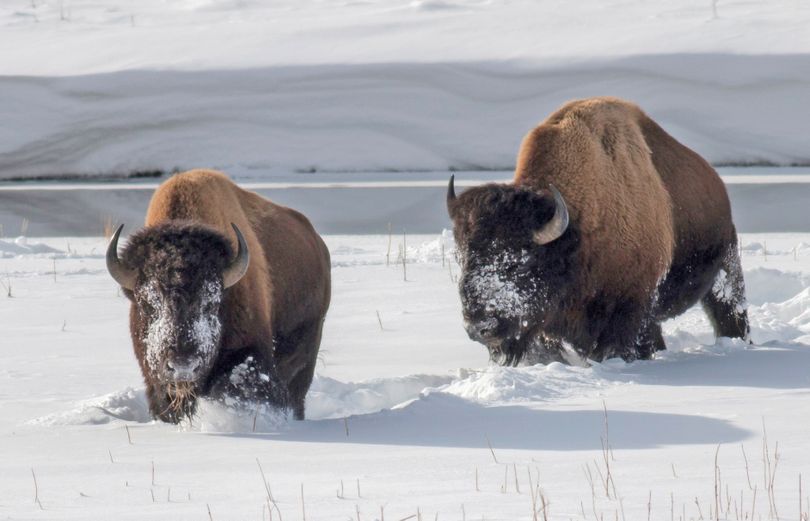Bison hunters offered holistic deal after their kill

HUNTING -- A group founded in the Methow Valley is taking a stab at reviving the spiritual and physical values of bison by taking on the dirty work of processing the kills of Yellowstone-region hunters.
The eight members of this year’s Buffalo Bridge are honoring “the innate worth of the buffalo” while attempting to build cultural ties to tribal members who have renewed their bison treaty hunting rights outside Yellowstone National Park, reports Brett French outdoor writer for the Billings Gazette.
To do that, the group offers to help all of the nearby bison hunters — tribal and nontribal — to gut, skin and haul their kill at no charge. In return, they claim any unused bison parts for their own needs — less choice cuts of meat for food, hides for tanning, and bones for making tools and utensils like ancient people.
“For Plains people the buffalo were everything; their homes and clothing were made from the hides, the horns made ladles, buttons and spoons, sinew provided thread for sewing, scrapers were made from vertebrate," said Josh Dodds, a 40-year-old project member from Oregon. "Their entire livelihood was based on the bison.”
To the American Plains Indians, French reports, a bison was "kind of like an ancient and wild Wal-Mart of the prairie."
Here's more from the Gazette:
This is the third year the group has set up shop in canvas wall tents across from Beattie Gulch, one of the prime bison-hunting spots in the Gardiner Basin.
“We really fill a niche here,” said Katie Russell, founder of Buffalo Bridge.
Russell is a long way from her Palmyra, N.Y., childhood home. But even as a young girl she was gutting and skinning the squirrels her brother would shoot. So advancing to full immersion into a buckskin culture wasn’t such a big jump. Now she even teaches other young squirrel skinners primitive skills through her Wilderbabe business in Winthrop, Wash.
“There’s a sense of loss among some modern people, and this gives them a sense of connectedness,” said Dodds about primitive skills workshops he’s attended and the vibe at Buffalo Bridge.
Russell shows guests around on this day while wearing a buckskin shirt adorned with a fox fur collar. The fur came from a fox she found dead along a road on Valentine’s Day.
Her friend Alex, a 28-year-old Buffalo Bridge member who like many would only give one name, has also recycled road kill. His bobcat fur hat with ear flaps was his first attempt at sewing a hat, one he had to disassemble and rebuild after the first design failed. He’s also wearing a coyote fur vest.
Wearing the vest while skinning a bison and hearing wolves howl in the distance was an enthralling experience for Alex.
“The wildness here is just phenomenal,” he said, a broad grin showing through his full beard.
Scraping bison hides is the Buffalo Bridge members’ most intensive and obvious task. Stretched out tautly in wooden frames or staked out on the ground, they look larger than possible, even though a bull bison can grow to 2,000 pounds.“If you keep the moisture in the hide it’s easier to scrape,” Barnes said.
He’s been experimenting with trying to keep a hide moist, despite the freezing cold, by covering it with other hides.
“I like to experiment,” he said while kneeling alongside the hide and sharpening a metal scraper. “Yeah, most of us don’t have real jobs, but I’m not going to waste my time” by performing a task inefficiently.
Barnes, a Missoula-area homesteader, said he enjoys living off the land by collecting berries and plants and gardening in the summer, and even making his own felted wool hat. He found the bison fat to be great fire starter, and once rendered in a crockpot it serves as a superior cooking oil — like Crisco — a lip balm and even a waterproofing treatment for leather boots.
“In some ways it’s romantic to do it over a fire,” Alex said. “But we’ve been doing it in a crockpot, melding the old and the new ways.”
“It’s some of the best fat you’ve ever seen,” Dodds said of the butter-yellow grease.
Repurposing bison parts has become a specialty of all of the Buffalo Bridge members. Atop a faded wooden picnic table sit bison rib bones tied together, an experiment in constructing a child’s sled. The large bison hooves can be turned into door knockers. Tails hanging from the center pole of the kitchen tent to dry could become decorations for skirts, a fly swatter or a distracting toy for a baby. A buffalo hide serves as an insulating rug inside the tent as well as a throw over the couch.
Although the group may be melding modern technology with traditional skills, trying to categorize them is scorned. Others have tried, calling them “anarchical primativists” and American Indian wannabes.
“At some point we all lived off the land like Indians and wore skins,” said Epona, a 29-year-old Buffalo Bridge member. “There’s a difference between using their technology and taking someone’s symbolism — taking their symbols and trying to copy it.”
They also aren’t re-enactors like Civil War or mountain men enthusiasts who accumulate clothing and gear from those eras to dress up for rendezvous or to recreate famous battles.
“I’m not replicating anything,” Russell said. “I’m trying to find a new way.”
“The new old good way,” Epona called it.
